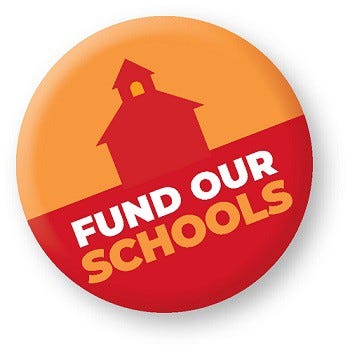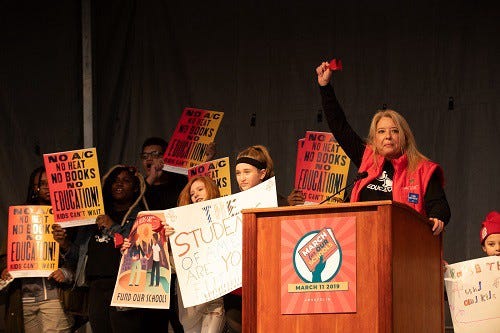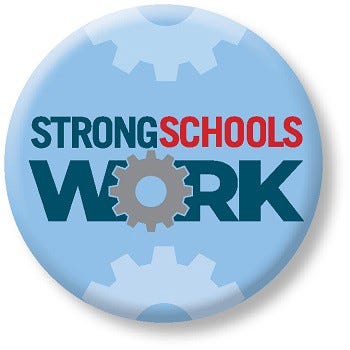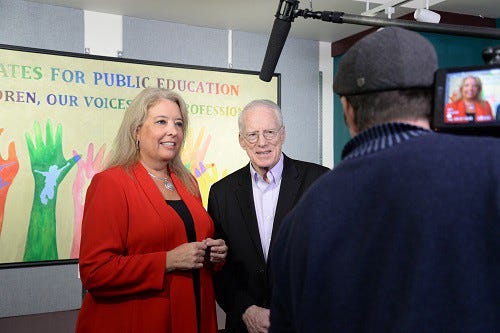Strong Schools Work for Everyone
The Blueprint for Maryland’s Future Works for Kids, Families, Communities, and Our Future

Educators and public education activists throughout Maryland are approaching the outcome of three years of hard work — work specifically focused on making game-changing improvements to public education for every student, family, and community. “We’re at a crossroads,” says MSEA President Cheryl Bost. “And we have a chance now to lift our students and educators up so they can succeed in their classrooms, their futures, and their professions.”

MSEA members aren’t the only Marylanders feeling some degree of awe at the prospect of truly meaningful education reforms. The man taking over for the legendary Mike Miller as Maryland Senate president, Bill Ferguson (D-Baltimore City), told the Washington Post that the Blueprint for Maryland’s Future is “going to take up a lot of the energy. “This is a generational moment for public education.”
Ferguson and Speaker of the House Adrienne Jones (D–Baltimore County) are leading the work in the 2020 General Assembly to pass the Blueprint — the most important education legislation to reach legislators in 20 years. “This will be the session for Maryland children,” House Speaker Jones told her colleagues.
Just tuning in? Catch up with the Kirwan Commission and the Blueprint for Maryland’s Future here.
There’s much work to do before the close of the session in April. “Last year, thousands of educators, students, and Marylanders came to Annapolis to rally and say that our kids can’t wait,” says Bost. “We won $1.1 billion in new funding over the next three years. This year, our goal is to set in stone long-term, equitable, and adequate funding increases by passing the Blueprint and a new school funding formula.”
Why We Need the Blueprint for Maryland’s Future
Since legislators passed the Bridge to Excellence in Public Schools Act (also known as the Thornton Plan) in 2002, Maryland has tried to provide adequate and equitable funding to all school systems.

Unfortunately, the funding formula developed by Thornton is no longer keeping up with the needs of our students. The percentage of Maryland public school students living in poverty has more than doubled since 1990 — from 22% to 45% — putting our statewide student population on the verge of becoming majority low-income.
When you consider those increased needs together with the higher standards and new programs implemented over the last five years alone, our current levels of education spending fall short for too many students.
Changes in student demographics and needs, plus a crisis in recruiting and retaining new teachers, show the need for increased education funding. We need strong schools to make sure every student has what they need to succeed. The Blueprint would be a gamechanger for students, educators, and communities across the state — delivering resources and support where it’s needed and where it will make big differences in our schools.
Where Will the Funding Come From?
Early on in the General Assembly, much of the conversation has focused on cost. But the good news is that the vast majority of the Blueprint is already funded.
The Kirwan Commission has recommended that at full phase-in (10 years from now), an additional $4 billion would be spent on public schools to expand career and technical education programs, provide more resources for students from backgrounds of poverty and students with special needs, increase educator pay, hire more educators, and more equitably fund schools.
The Baltimore Sun has reported that “routine growth in the state budget, through increasing population, higher salaries and housing prices, will add billions to the state’s budget for education over 10 years without additional taxes,” which will cover about 70% of the new funding formula.

The legislature — and voters — have already begun to take action to cover the remaining amount. In 2018, 89% of Marylanders voted for Question 1 to ensure that casino revenues would go to increasing school funding. This is projected to add $500+ million per year in new school funding. And during the 2019 General Assembly session, legislators took action to comply with the Supreme Court’s Wayfair decision to collect revenue from online sales from out-of-state companies, adding millions more annually for school funding.
You and your neighbors may have heard opponents of the Blueprint warning of “exorbitant” tax increases. No one, other than opponents of the bill, are proposing such increases. They’re fictitious — because they’re unnecessary.

“We’ve seen a lot of wildly inaccurate numbers thrown around about how much the blueprint would cost. Here’s the deal:
Budget analysts have found that routine growth in population and economic activity will cover about 70% of the new funding formula.
The legislature, and voters, have already begun to cover the rest through passing Question 1 in 2018 and taking action to comply with the Supreme Court’s Wayfair decision, collectively adding hundreds of millions of dollars more annually for school funding. Poll after poll has shown that Marylanders overwhelmingly support increasing school funding. The only people talking about massive tax increases are those who oppose this historic investment in our schools. Our kids deserve better than scare tactics.” –MSEA President Cheryl Bost, Daily Record
Investing in What Is Proven to Work
The Blueprint doesn’t throw money at problems — it invests in real solutions. Many states have attempted to improve their schools simply by delivering additional funding to school districts to spend as they chose. The results have been mixed.
That’s not what is being proposed here in Maryland. Instead, the Kirwan Commission has spent three years incorporating into their recommendations the programs and policies that have worked in the highest-performing states and countries.

These recommendations include proven measures such as expanding career and technical education, community schools, and pre-k; increasing educator pay; hiring more educators to increase individual attention for students and to expand teacher planning and collaboration time; and providing more support for special education and mental health services.
These initiatives have moved the needle in the states and countries where they have been implemented, and the new accountability provisions in the Blueprint for Maryland’s Future will make sure that they are implemented with fidelity and produce results.
“I think there is high confidence that if we implement these recommendations, we’re going to have one of the best school systems in the world because we are adopting best practices that have been employed in the best performing systems in Europe, Asia, and Canada,” Brit Kirwan, head of the Kirwan Commission, told the Senate Education, Health, and Environment Affairs Committee on January 12.

“This is a huge moment for our state. We have a big choice to make. Are we going to accept the status quo and hope we can become incrementally better,” Kirwan added, “or are we going to do something bold and make a big investment to build a world class workforce and give every kid in every zip code a chance to pursue the American dream?
“That’s what we need to answer this session.”

